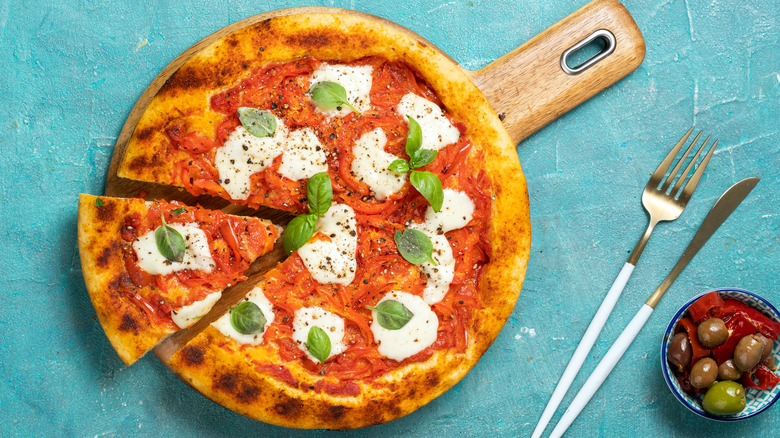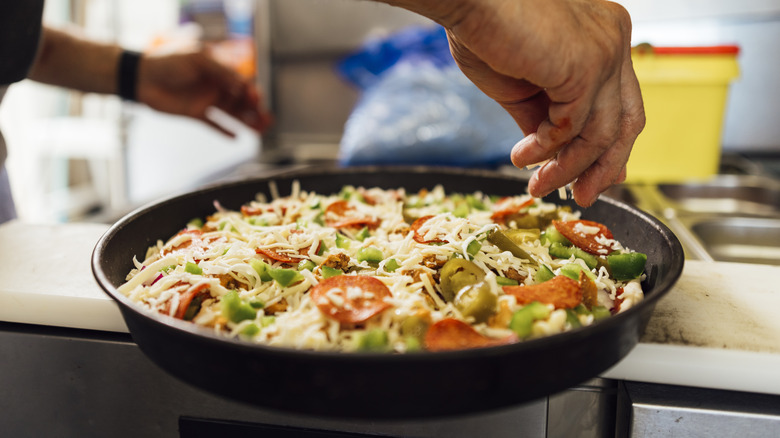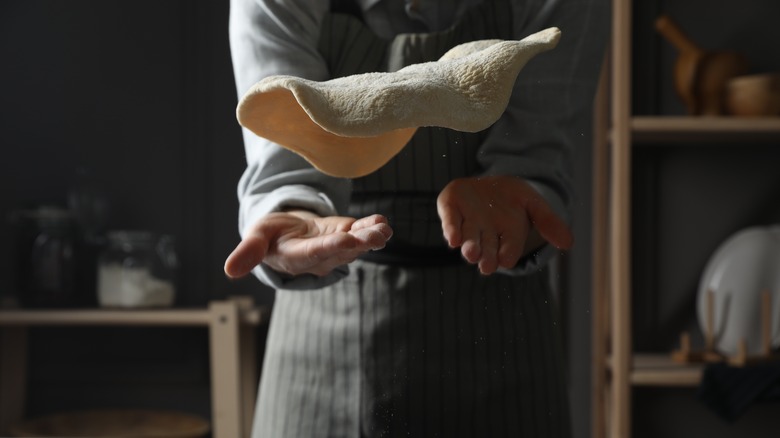The Actual Difference Between Pan Pizza And Hand-Tossed Pizza
Pizza may be universally loved, but the dish is anything but one-size-fits-all. When it comes to toppings, some are devout pepperoni lovers, while others swear by pineapple. Marinara, white sauce, pesto... the options are endless. But while toppings tend to hog the spotlight, it's the crust that quietly makes or breaks the entire slice.
While there are at least 15 different types of pizzas in the U.S., two of the most common styles that get their characteristic features from the dough are pan pizza and hand-tossed pizza. Pan pizza (sometimes referred to as deep dish) is spread out in an oiled cast-iron skillet or even a cake pan, where it puffs up into a thick, golden base. Hand-tossed dough, on the other hand, is kneaded until soft, stretched, and tossed in the air. These prep methods aren't just a matter of style, however — they actually make a world of difference in the texture, flavor, and even structural integrity of your slice.
Pan pizza gives you the chewiest bite
Pan pizza is one of the simplest ways to make this tasty Italian fare, and it's all thanks to the pan you bake it in. By using a cast-iron skillet, the dough is pressed into the base, allowing the walls of the dish to shape it into a perfect circle. After layered with cheese and toppings, the pizza is placed in the oven and its dough rises into a thick, pillowy base with a puffy crust, perfect for dipping in marinara afterwards. Due to its thickness, there's also no need to pick and choose between toppings, as the sturdy base will be less likely to tear. One helpful tip to avoid any sauce seeping through the bottom is layering on cheese first to act as a barrier and keep your golden crust intact.
Another key difference between the two pizza styles lies in the baking. While hand-tossed pizza is cooked exclusively in the oven, pan pizza can be pre-baked briefly on the stove to prevent any large air bubbles from forming while in the oven. Once your pan pizza is finished cooking, the result is a beautifully crispy, almost fried crust with a chewy interior and zero sogginess.
For a lighter dinner, go for hand-tossed pizza
Hand-tossed pizza offers the classic thin crust that you'll likely find at most pizzerias — New-York style and the traditional Pizza Napoletana are two of the most popular varieties that require a hand-tossed dough. By tossing it into the air, air bubbles in the dough are worked out, leading to less rise in the oven. Despite its name, however, hand-tossed pizza doesn't necessarily have to be thrown into the air to be considered hand-tossed. Another option is to shape the dough by gently stretching it with your fingers until it's about ¼ inch thick. However you form the dough, just be sure you're using your hands, as using a rolling pin can ruin your pizza crust in an instant. The result you're looking for in a good hand-tossed pie is thin, airy, and slightly chewy. And, since each pizza is formed by hand, the results are more varied, so don't worry about getting a perfect circle.
The outer crust of hand-tossed pizza is thinner and softer than pan pizza, with just enough crispness to support your favorite toppings. Unlike the sauce, cheese, and topping tower that pan pizza can handle, hand-tossed pizza is better suited for lighter combinations, like a classic Margherita, cheesy fig and arugula pizza, or even a pesto chicken pizza. Once it's ready to hit the oven, these pizzas just need a quick bake thanks to their thinness (10 to 15 minutes, compared to pan pizza's 25 to 35 minutes).



